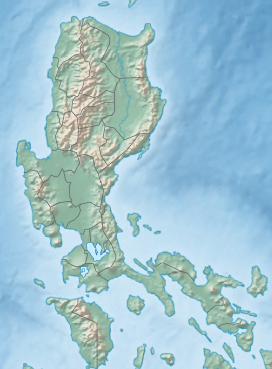| Mount Halcon | |
|---|---|
 View of Mt. Halcon from Barangay Dulangan II View of Mt. Halcon from Barangay Dulangan II | |
| Highest point | |
| Elevation | 2,616 m (8,583 ft) |
| Prominence | 2,616 m (8,583 ft) |
| Listing | |
| Coordinates | 13°15′00″N 120°59′00″E / 13.25000°N 120.98333°E / 13.25000; 120.98333 |
| Geography | |
  | |
| Country | Philippines |
| Region | Mimaropa |
| Province | Oriental Mindoro |
| City/municipality | Baco |
| Parent range | Mindoro Mountain Range |
| Climbing | |
| First ascent | 1906 by American botanist Elmer Drew Merrill and company. |
Mount Halcon (Filipino: Bundok Halcon) and (Spanish: Monte Halcón) is the highest mountain in Mindoro. According to the new data released by Oriental Mindoro peakvisor as of 2022, it has an elevation of 2,616 metres (8,583 ft) above sea level, higher than the previous estimates of 2,586 m (8,484 ft) although no official survey has yet confirmed this. It is the 23rd-highest peak in the Philippines and 37th-highest peak of an island on Earth. Its steep slopes have earned it the reputation of being one of the most difficult and technically most challenging mountains to climb in the Philippines. The first documented ascent was made in 1906 by American botanist Elmer Drew Merrill and a party of forestry and military personnel.
Inhabitants
Mount Halcon is home to the indigenous Alangan Mangyans.
Flora and fauna
Its thick vegetation contains much flora and fauna, including the critically endangered Mindoro bleeding-heart which is endemic to the area, and the stick insect Conlephasma enigma, which was first described in 2012.
History
The mountain was also the location of a possible World War II Japanese holdout. Isao Miyazawa found evidence that his comrade Captain Fumio Nakahara was living there in 1957. Another search in 1977 was called off due to Miyazawa contracting malaria. In 1980, Miyazawa found Nakahara's hut, and the natives talked to him extensively about the foreigner. However, Nakahara himself has never been spotted.
See also
References
- The highest mountains in the Philippines. Pinoy Mountaineer – Your Guide to Hiking in the country. 2008-02-02. . Retrieved 2011-09-15.
- Hay, Ida (1998). "E. D. Merrill, From Maine to Manila" (PDF). Arnoldia. 58 (1): 11–19.
- Alangan Mangyan. National Commission on Indigenous Peoples. "Alangan Mangyan". Archived from the original on 2011-02-13. Retrieved 2011-09-15.. Accessed on 2011-09-15.
- Mount Halcon. Birdlife International. . Accessed on 2011-09-15.
- Wakler, Matt (2012-09-04). "'Mystery' stick insect discovered". BBC. Retrieved 2012-09-04.
- 宮沢, 功 (1957). "連載 サラリーマン男のロマン ミンドロ島戦友捜索奮戦記". 実業之日本. 83 (6). Jitsugyo no Nihon Sha: 102–105.
- Mainichi Shimbun, Mainichi News Compilation 1977, p. 900
- "Still fighting, 35 years after V-J day," Finger Lakes Times. April 10, 1980, p1
- "The Last Last Soldier?," TIME, January 13, 1975
- "Still fighting, 35 years after V-J day," Finger Lakes Times. April 10, 1980, p. 1.